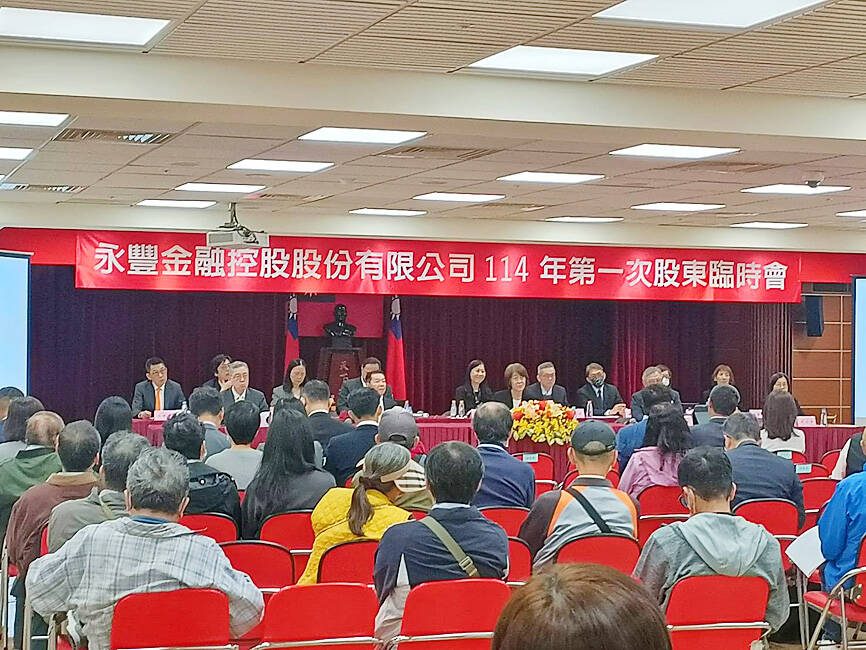Shareholders of SinoPac Financial Holdings Co (永豐金控) and King’s Town Bank (KTB, 京城銀行) yesterday approved a merger plan that could make SinoPac Taiwan’s seventh-largest financial conglomerate.
The companies signed a merger agreement in December last year according to which SinoPac would buy 100 percent of KTB shares for NT$60 billion (US$1.82 billion) through cash and share swaps.
Under the share swap, one common KTB share would trade for 1.15 SinoPac shares, the companies said.

Photo: Lee Chin-hui, Taipei Times
SinoPac Financial president Stanley Chu (朱士廷) has said the integration would enable SinoPac to serve more customers in southern Taiwan.
Most of Tainan-based KTB’s 66 branches are in Yunlin County, Chiayi County, Tainan, Kaohsiung and Pingtung County, while most of SinoPac’s 125 branches are in northern Taiwan, Chu said.
KTB chairman Tai Chen-chih (戴誠志) has said he intends to retire and the lender’s vice chairman Tsai Chiung-ting (蔡炅廷) has said he is not interested in taking over.
Tai and Tsai would not join SinoPac’s boardroom following the completion of the one-year integration, as they prefer to be shareholders and trust SinoPac’s management to the board, Chu said.
SinoPac said would next seek approval from the Financial Supervisory Commission for the acquisition, even though the KTB workers’ union last week rejected its retention and compensation offers.
SinoPac earlier said it would retain all KTB employees for at least three years and would provide bonuses for those who choose to stay, especially banking professionals.
The premium linked to the buyout bid has fallen from 8.8 percent in December last year to 4.36 percent on Thursday last week, as a result of local share corrections, Taiwan Stock Exchange data showed.
The merger would also make SinoPac’s banking arm Bank SinoPac (永豐銀行) the third-largest lender in Taiwan by measure of loans to small and medium-sized enterprises, SinoPac Financial said.
KTB focuses on commercial banking, while SinoPac is more specialized in institutional banking and serving firms with larger amounts of capital, Chu said.
KTB would auction off its capital leasing unit and liquidate its securities arm, as the former has a different business orientation from SinoPac’s capital leasing unit, the two sides said.

Shares in Taiwan closed at a new high yesterday, the first trading day of the new year, as contract chipmaker Taiwan Semiconductor Manufacturing Co (TSMC, 台積電) continued to break records amid an artificial intelligence (AI) boom, dealers said. The TAIEX closed up 386.21 points, or 1.33 percent, at 29,349.81, with turnover totaling NT$648.844 billion (US$20.65 billion). “Judging from a stronger Taiwan dollar against the US dollar, I think foreign institutional investors returned from the holidays and brought funds into the local market,” Concord Securities Co (康和證券) analyst Kerry Huang (黃志祺) said. “Foreign investors just rebuilt their positions with TSMC as their top target,

REVENUE PERFORMANCE: Cloud and network products, and electronic components saw strong increases, while smart consumer electronics and computing products fell Hon Hai Precision Industry Co (鴻海精密) yesterday posted 26.51 percent quarterly growth in revenue for last quarter to NT$2.6 trillion (US$82.44 billion), the strongest on record for the period and above expectations, but the company forecast a slight revenue dip this quarter due to seasonal factors. On an annual basis, revenue last quarter grew 22.07 percent, the company said. Analysts on average estimated about NT$2.4 trillion increase. Hon Hai, which assembles servers for Nvidia Corp and iPhones for Apple Inc, is expanding its capacity in the US, adding artificial intelligence (AI) server production in Wisconsin and Texas, where it operates established campuses. This

US President Donald Trump on Friday blocked US photonics firm HieFo Corp’s US$3 million acquisition of assets in New Jersey-based aerospace and defense specialist Emcore Corp, citing national security and China-related concerns. In an order released by the White House, Trump said HieFo was “controlled by a citizen of the People’s Republic of China” and that its 2024 acquisition of Emcore’s businesses led the US president to believe that it might “take action that threatens to impair the national security of the United States.” The order did not name the person or detail Trump’s concerns. “The Transaction is hereby prohibited,”

Garment maker Makalot Industrial Co (聚陽) yesterday reported lower-than-expected fourth-quarter revenue of NT$7.93 billion (US$251.44 million), down 9.48 percent from NT$8.76 billion a year earlier. On a quarterly basis, revenue fell 10.83 percent from NT$8.89 billion, company data showed. The figure was also lower than market expectations of NT$8.05 billion, according to data compiled by Yuanta Securities Investment and Consulting Co (元大投顧), which had projected NT$8.22 billion. Makalot’s revenue this quarter would likely increase by a mid-teens percentage as the industry is entering its high season, Yuanta said. Overall, Makalot’s revenue last year totaled NT$34.43 billion, down 3.08 percent from its record NT$35.52